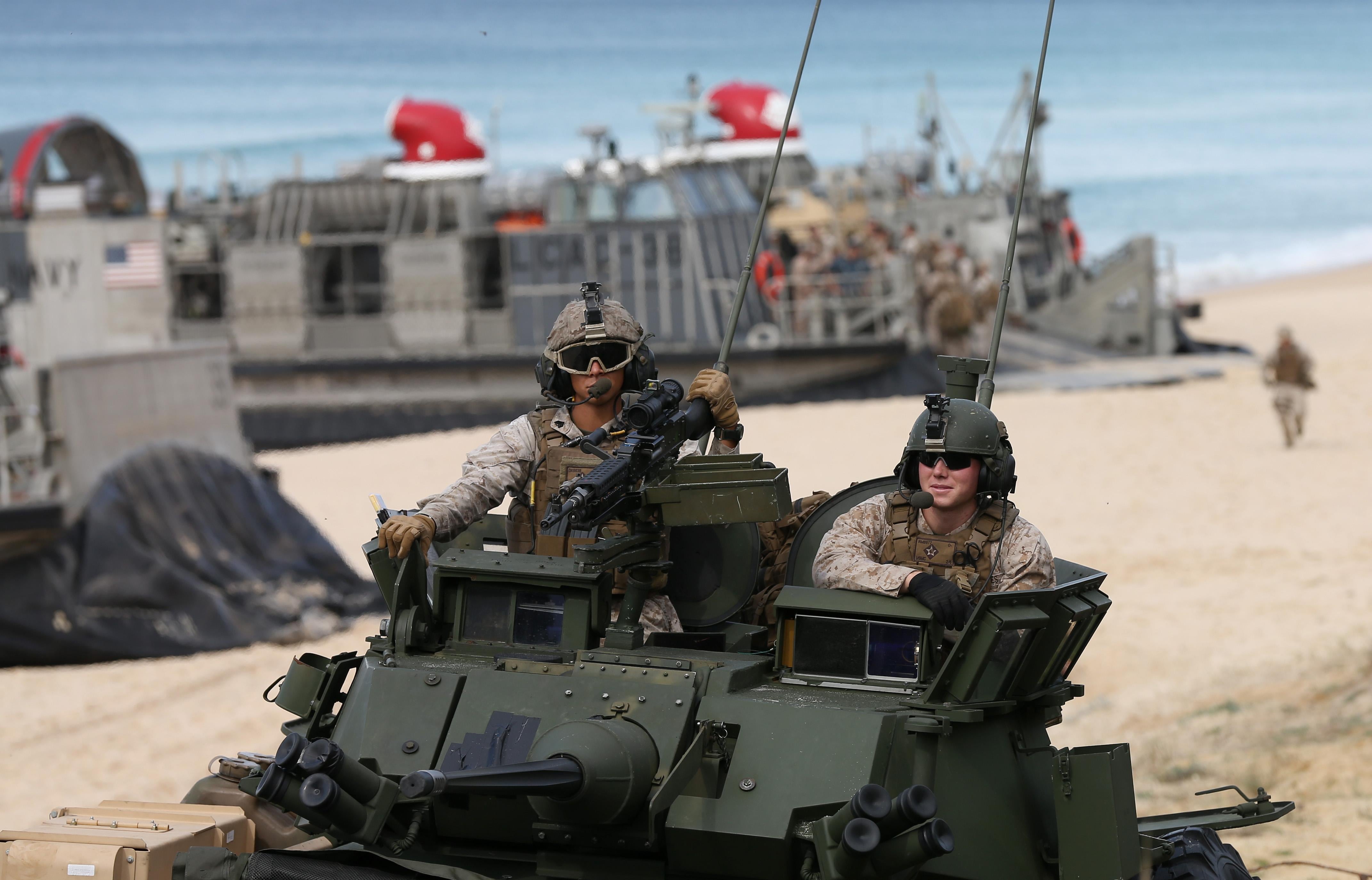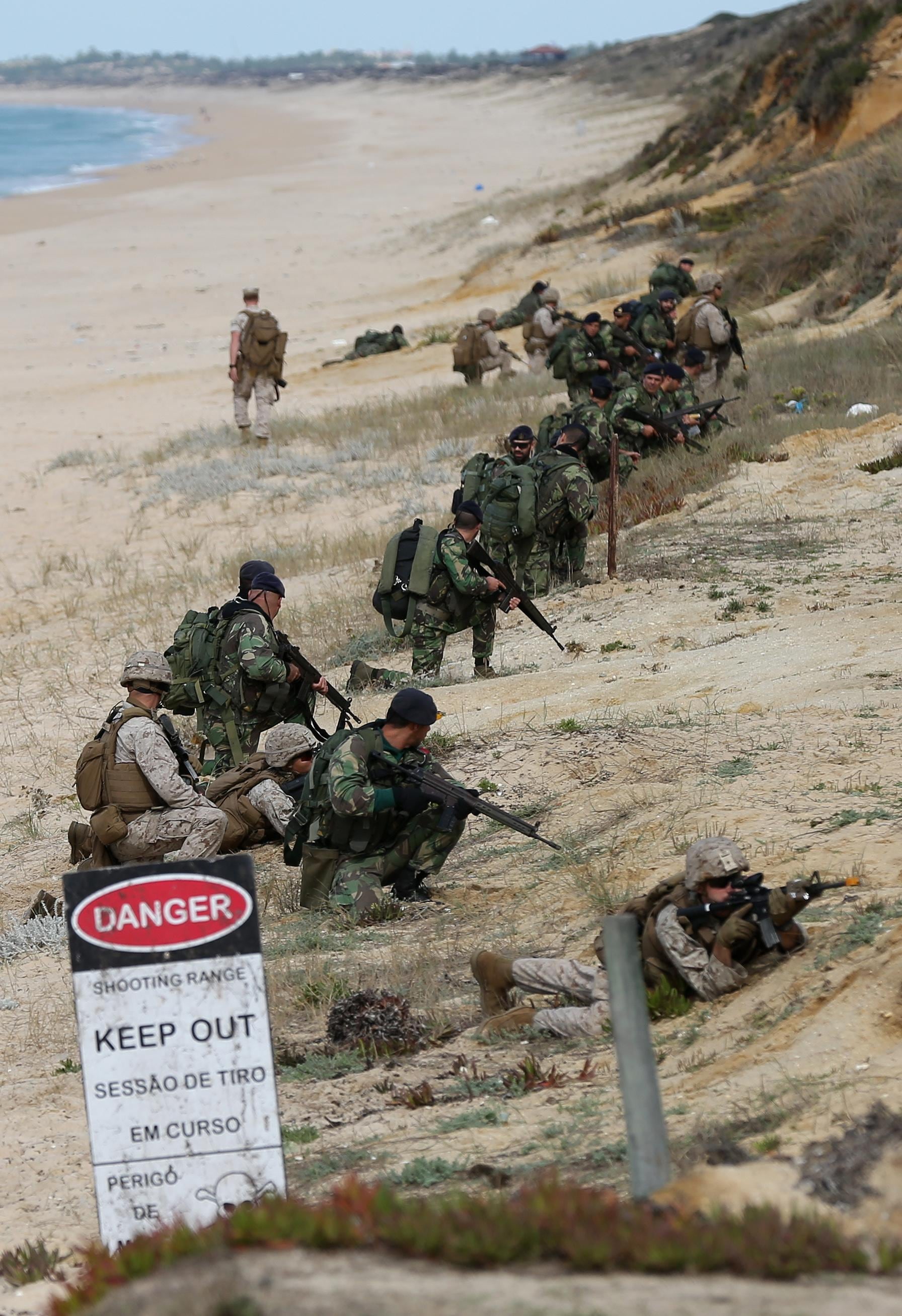PINHEIRO DA CRUZ, Portugal — U.S. Marines and other NATO troops staged a mock amphibious assault on Europe's coastline Oct. 20 as part of the alliance's biggest exercise in 13 years — an event intended to demonstrate its conventional military muscle and send a message of warning to potential foes.
The Trident Juncture training event being held through Nov. 6 in Portugal, Spain and Italy involves some 36,000 soldiers, sailors and airmen from some 30 countries, with more than 200 aircraft and over 60 ships and submarines.
In addition to NATO allies, participants in the exercise, which opened Oct. 19 at Trapani Air Base, Sicily, include Australia, Austria, Bosnia and Herzegovina, Finland, Macedonia, Sweden and Ukraine.
Trident Juncture "sends a message (that) the alliance is strong (and) we're going to take care of each other," U.S. Rear Admiral Roy Kitchener, chief of staff of NATO Naval Striking and Support Forces, told The Associated Press during the amphibious maneuvers in Portugal.
The weeks of maneuvers are also testing the flagship NATO Response Force — quick-deployment units created in 2014 and due to be ready next year.

Marines drive their armored vehicle off the beach at Pinheiro da Cruz, Portugal, during a mock amphibious assault with Portuguese troops Oct. 20.
Photo Credit: Steven Governo/AP
Huge U.S. Navy hovercraft from the amphibious transport dock Arlington landed on the beach here, about 60 miles south of the Portuguese capital Lisbon. They generated clouds of spray and noise as they delivered U.S. and Portuguese Marines and armored vehicles to the beach while U.S. Navy helicopters flew overhead. Arlington is part of the Kearsarge Amphibious Ready Group.
In the imagined scenario, NATO was projecting force to help a friendly country that requested help to re-establish order.
U.S. Marines taking part in the exercise include Special Purpose Marine Air-Ground Task Force–Crisis Response–Africa, the 4th Light Armored Reconnaissance Battalion and the 26th Marine Expeditionary Unit, which is embarked with the Kearsarge ARG.

US marines and portuguese fuzileiros hold their positions after getting off US Navy hovercrafts during the NATO Trident Juncture exercise 2015 at Raposa Media beach in Pinheiro da Cruz, south of Lisbon, Tuesday, Oct. 20, 2015. NATO Allies and partner nations join forces for the next three weeks for the Alliance's Trident Juncture live military exercise involving 36,000 troops from more than 30 nations across Portugal, Italy and Spain. (AP Photo/Steven Governo)
Photo Credit: Steven Governo / AP
"Participating in an exercise of this scale is important for the Navy and Marine Corps because it demonstrates our nation's commitment to NATO and our collective defense responsibilities," said Marine Lt. Col. Daniel Coleman, the commander of the 26th MEU, in a news release.
"It also allows us to strengthen partnerships and improve our ability to operate and cooperate with allied militaries. This exercise is an opportunity to see how our tactical training and preparation has strategic importance.. ... [It] demonstrates our nation's commitment to securing important interests."
The Trident Juncture exercise shows "that NATO is still apt and capable to deploy a major military force to deter an attack," said Bruno Lete of the German Marshall Fund of the United States, a Brussels-based nonprofit research group. "The symbolism is very important."
He noted that NATO has devoted lots of energy recently to Eastern Europe, and "now it is showing it is here to defend Southern Europe, too." NATO top brass are rethinking their strategy in Southern Europe due to events in the Mediterranean, especially Libya and Syria, he said.
Although NATO officials said the exercise is not aimed at Russia, Cold War-like tensions were clearly on their minds.
"We are very concerned about the Russian military build-up," NATO's Deputy Secretary General Alexander Vershbow told reporters. "The increasing concentration of forces in Kaliningrad, the Black Sea and now in the eastern Mediterranean does pose some additional challenges."
The geopolitical situation is considerably more unstable than the last time such large-scale exercises were held during the Cold War, he said, citing Russia's annexation of Crimea, support of eastern Ukrainian separatists and attacks against moderate rebels in Syria, as well as the spread of terror groups into Libya and Syria.
"In this new world, NATO's allies and partners must be able to move quickly and act decisively," he said.
The amphibious assault was not without mishaps. The beach was too steep for the hovercraft to land at their first attempt, requiring them to go back out to sea and try again, and the first two armored vehicles onto the beach got stuck in the sand.
Reporter Esteban Villarejo of Defense News, a sister publication, and The Associated Press contributed to this report.





